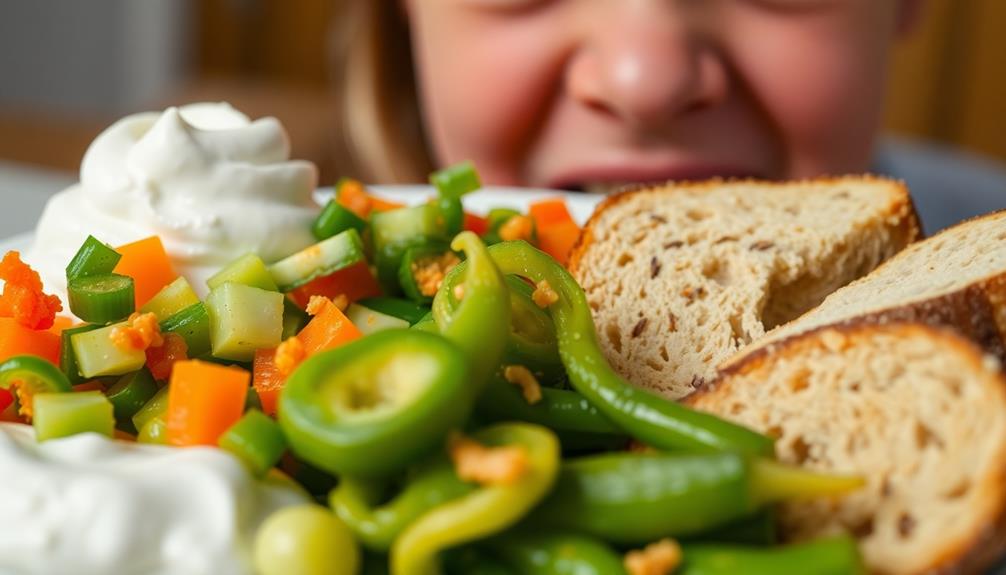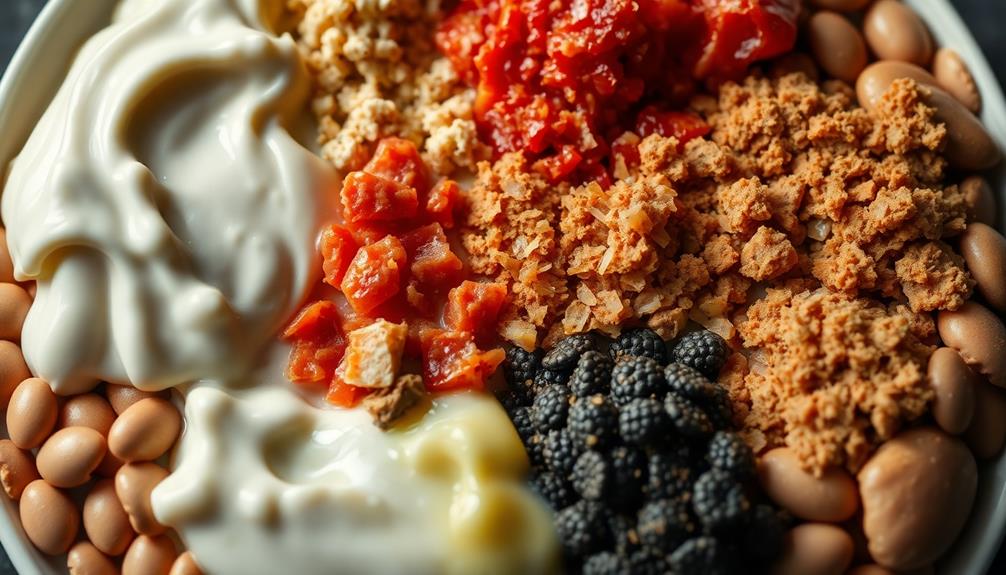The neuroscience of food texture aversions highlights how your brain processes sensory information, triggering strong reactions to certain textures. It's often not about taste or smell, but rather how the brain interprets sensory input. Sensory Processing Disorder can heighten these sensitivities, making mealtime challenging. Past experiences and genetics also play a role, which might limit your dietary choices. This can lead to nutrition gaps if you avoid a variety of foods. Gradual exposure and positive reinforcement can help overcome these challenges. Keep going, and you'll discover strategies to improve your relationship with food textures.
Key Takeaways
- Sensory Processing Disorder (SPD) heightens sensitivity to food textures, leading to aversions based on neurological responses rather than taste or smell.
- The brain's interpretation of sensory input influences how individuals react to different food textures, causing distress during mealtime.
- Genetic factors and past experiences contribute to food texture aversions, impacting dietary choices and preferences across generations.
- Gradual exposure to diverse textures can help mitigate aversions by allowing the brain to adapt and reduce negative reactions.
- Professional guidance in sensory processing can provide tailored strategies to manage texture sensitivities and expand dietary options effectively.
Understanding Food Texture Aversions

Why do some children turn their noses up at certain foods? The answer often lies in food texture. Kids with sensory sensitivity might refuse foods due to their textures rather than their tastes or smells.
For instance, they may find creamy textures, like those in a Nettle and Potato Soup, unappealing if they prefer smoother options. This refusal can lead to food aversions, causing significant mealtime distress and anxiety. If a child has had a negative experience with a specific food texture—like crunchy or slimy—they're likely to avoid those textures altogether.
When children have texture sensitivities, it can limit their dietary variety, resulting in nutritional deficiencies. Without a broad selection of foods, they may miss out on essential nutrients vital for their growth and development.
To help them embrace new textures, gradual exposure is key. This approach gently introduces various food textures over time, making it easier for your child to adapt. Positive reinforcement can also encourage them to try new foods without fear.
Involving healthcare professionals can provide tailored dietary plans that address these aversions while ensuring your child gets the nutrition they need. By understanding food texture aversions, you can create a supportive environment that fosters healthier eating habits.
The Role of Sensory Processing

When you think about food texture aversions, it's crucial to recognize how sensory processing disorder (SPD) shapes those experiences.
For instance, dishes like Chinese Steamed Egg may be particularly challenging for individuals sensitive to smooth and custard-like textures.
If you or someone you know struggles with heightened sensitivity to textures, those reactions often stem from the brain's interpretation of sensory input.
Understanding these origins can lead to better strategies for addressing and managing these aversions.
Sensory Processing Disorder Effects
Sensory Processing Disorder (SPD) greatly impacts how individuals, especially children, interact with their environment, particularly regarding food textures. The heightened sensitivity often leads to food aversion, resulting in feeding disorders and limited dietary variety. You might notice extreme reactions like gagging or distress when your child encounters certain textures, which can create anxiety around mealtime.
| Food Texture | Child's Reaction | Impact on Diet |
|---|---|---|
| Smooth | Acceptance | Increased intake |
| Gritty | Gagging | Avoidance of foods |
| Slimy | Distress | Nutritional deficiency |
Understanding sensory processing is vital for managing these reactions. Children with SPD may reject foods due to negative past experiences or genetic predispositions. This can lead to a food intake disorder, complicating their relationship with nutrition. Gradual exposure to new textures, coupled with professional guidance, can help ease these aversions. By recognizing the effects of SPD, you can better support your child in developing a healthier relationship with food.
Texture Sensitivity Origins
Understanding the origins of texture sensitivity reveals how sensory processing affects children's interactions with food. For many kids, particularly those with Sensory Processing Disorder (SPD), the brain's handling of sensory information can lead to heightened sensitivity to food textures. This means that rather than rejecting foods based solely on taste or smell, they might refuse them because of unpleasant textures, resulting in significant food texture aversions.
For instance, certain traditional dishes like Muamba De Galinha may contain textures that can be off-putting for sensitive children, further complicating their willingness to try new foods. Kids with SPD often show extreme reactions, like gagging or distress at mealtimes, which can disrupt their eating habits and nutrition. Genetic factors and past negative experiences with certain textures play essential roles in developing these aversions. Additionally, environmental influences, like a limited food variety, can intensify these challenges.
Neurological conditions such as autism spectrum disorder and ADHD frequently accompany sensory processing issues, further increasing texture sensitivities. Early identification of these sensory processing challenges is imperative. By recognizing texture sensitivity early, you can implement effective strategies, helping your child develop healthier eating habits and improving their overall quality of life.
Understanding these origins can empower you to support your child's nutritional needs better.
Causes of Texture Sensitivity

Texture sensitivity can stem from a variety of sources that affect how you perceive and react to different food textures. One major factor is sensory processing disorder (SPD), where your brain struggles to process normal sensory input, leading to heightened reactions to certain textures. Genetic predisposition and negative past experiences, like choking, can also contribute to food texture aversions, especially in children.
Children with autism spectrum disorder or ADHD often exhibit these sensitivities, complicating their acceptance of different foods. Environmental factors play an essential role too; limited exposure to various textures during early childhood can exacerbate aversions and result in restrictive eating patterns. Additionally, psychological factors—such as anxiety and stress—can intensify your texture sensitivities, making it even harder to try new foods.
Here's a quick overview of the causes:
| Factor | Description | Impact on Texture Sensitivity |
|---|---|---|
| Genetic Predisposition | Inherited traits influencing sensitivity | Increased risk of food texture aversions |
| Environmental Factors | Limited food exposure during childhood | Restrictive eating patterns |
| Psychological Factors | Anxiety and stress affecting perception | Heightened texture sensitivity |
Impact on Dietary Choices

Food texture aversions greatly shape dietary choices, particularly in children. When kids exhibit sensory sensitivity, they often develop food neophobia, which limits their dietary options and can lead to nutritional deficiencies. This aversion to certain textures can result in a narrow range of acceptable foods, making it challenging for them to enjoy diverse cuisines, such as the rich flavors of Indian meals.
In fact, children who prefer softer textures frequently struggle with social situations centered around food, feeling isolated or uncomfortable.
Here are some key impacts of texture aversions on dietary choices:
- Increased likelihood of picky eating behaviors
- Restricted access to essential nutrients
- Social discomfort during communal meals
- Difficulty in trying new foods due to texture preferences
- Need for targeted interventions to encourage food acceptance
Understanding these factors is vital for addressing food neophobia and improving children's dietary habits. By recognizing the influence of texture preferences, parents and caregivers can implement strategies to broaden their child's food choices.
Ultimately, fostering a more diverse palate can enhance both nutrition and social experiences, reducing the risks associated with a limited range of foods.
Parental Influence on Preferences

While many parents may believe their food preferences shape their children's choices, research suggests otherwise. A recent study revealed significant differences in food texture preferences between generations, with parents averaging a CFTPQ index of 68.3, while their children averaged only 52.4. This nearly null correlation (r = 0.04) indicates that parental influence on children's food texture preferences is limited.
In fact, only about 20% of children matched their parents' preferences, underscoring the divergence in texture aversions. For example, children may be more open to trying diverse textures in foods like Chilaquiles, which can feature a variety of toppings and ingredients, than their parents, who might've a more established preference for specific textures.
Interestingly, parents with high food neophobia tended to have children exhibiting distinct sensory processing traits. This connection implies that while your preferences mightn't directly dictate your child's texture choices, your own behaviors and attitudes towards food can influence their acceptance of various textures.
Understanding these generational differences is essential, especially when considering interventions aimed at improving children's dietary habits. By recognizing that children's food texture preferences often differ from yours, you can adopt strategies that encourage more adventurous eating without imposing your own preferences. In doing so, you may help foster healthier dietary habits in your children.
Treatment Approaches and Strategies

When tackling food texture aversions, gradual exposure techniques can make a big difference.
For instance, introducing dishes with diverse textures, such as Caldeirada or coconut candy, can help individuals become more accustomed to varying sensory experiences.
You can create a positive mealtime environment that encourages exploration and reduces anxiety around trying new textures.
Gradual Exposure Techniques
To effectively address food texture aversions, gradual exposure techniques offer a structured approach that can make trying new foods less intimidating. By introducing small amounts of aversive foods in a controlled manner, you can progressively increase the quantity over time, reducing sensitivity and promoting acceptance.
For instance, pairing new textures with comforting dishes, like braised beef in Barolo wine, can create a more enjoyable experience. Here are some strategies to reflect upon:
- Start with tiny portions of aversive foods.
- Pair new textures with preferred textures to ease the shift.
- Use positive reinforcement to encourage trying new foods.
- Implement desensitization techniques, like repeated exposure, in a supportive setting.
- Seek professional guidance to tailor strategies to individual needs.
These techniques not only help children acclimate to previously rejected textures but also foster a more open attitude towards diverse foods.
Incorporating preferred textures alongside aversive foods enhances the overall eating experience, making it easier for you to introduce new items.
Remember, patience is key. As you consistently apply gradual exposure, you'll likely notice increased willingness to experiment with different textures.
With the right support and approach, overcoming food texture aversions can become a manageable and rewarding journey.
Positive Mealtime Environment
Creating a positive mealtime environment can greatly enhance the effectiveness of gradual exposure techniques for food texture aversions. By minimizing stress and distractions, you can encourage exploration and acceptance of new foods, markedly reducing anxiety related to food. Here are some strategies to reflect on:
| Strategy | Description | Benefits |
|---|---|---|
| Involve children in prep | Let them help with cooking and serving | Increases interest and ownership |
| Offer varied food textures | Provide foods in different forms and textures | Expands food preferences gradually |
| Establish routine | Set specific dining times and family meals | Creates security and predictability |
| Use positive reinforcement | Praise or reward for trying new textures | Motivates overcoming aversions |
| Minimize distractions | Keep the dining area calm and focused | Reduces anxiety during meals |
Nutritional Considerations

Addressing nutritional factors for children with food texture aversions is crucial for their overall health and development. These children often face nutritional deficiencies due to a limited dietary variety, which can restrict their intake of essential food groups.
Incorporating diverse food options, such as traditional Ethiopian dishes like Yekolo (Roasted Barley), can provide important nutrients while catering to their texture preferences. To guarantee they receive a balanced diet, you can explore alternatives like smoothies and purees that cater to their texture preferences while delivering necessary vitamins and minerals.
Here are some key points to keep in mind:
- Monitor for nutritional deficiencies regularly.
- Include fortified foods to meet specific nutritional needs.
- Focus on macronutrient balance to support growth and development.
- Consult a nutritionist for tailored dietary recommendations.
- Pay attention to the sensory characteristics of the foods they're willing to accept.
Support Systems and Resources

Families maneuvering food texture aversions often find themselves in need of support and resources to help manage their child's unique challenges. One valuable option is joining support groups where you can connect with other families facing similar issues.
These groups provide shared experiences and practical solutions for navigating food preferences, including how to introduce American Diner Classics that may be more texture-friendly. Understanding sensory processing is essential, and educational materials can enhance your knowledge, offering strategies to address texture sensitivities effectively.
Cookbooks that focus on texture-friendly recipes can also be a game changer. They provide meal ideas that cater to various food texture preferences, making mealtimes less stressful for everyone involved.
Online forums and communities allow you to engage with others, sharing experiences, strategies, and success stories about managing food texture aversions.
Additionally, seeking professional support from therapists specializing in feeding and sensory integration can greatly aid your efforts. These experts can help develop effective strategies to improve eating habits and outcomes for your child.
Future Research Directions

Understanding food texture aversions opens doors to future research that can enhance interventions and support systems. By diving deeper into the scientific underpinnings of these aversions, you can contribute to more effective dietary strategies.
For instance, understanding how certain dishes, like Dorayaki (Red Bean Pancake), might evoke different texture responses can inform dietary preferences.
Here are some promising research directions you might consider:
- Investigate sensory processing traits to identify their links to food texture aversions and the neural mechanisms behind them.
- Examine familial resemblance in texture preferences to uncover genetic and environmental influences on children's dietary choices.
- Develop and test interventions that gradually expand children's food options, aiming to reduce food neophobia and increase acceptance.
- Explore the impact of parenting styles and the role of parental food neophobia on children's texture preferences, providing insights into family dynamics.
- Conduct longitudinal studies to track the evolution of texture preferences over time, shedding light on how experiences and physiological factors shape eating behaviors.
Frequently Asked Questions
What Is the Science Behind Food Aversions?
Food aversions often stem from negative experiences, like getting sick after eating. Your brain learns to associate certain foods with discomfort, leading you to avoid them, sometimes even after just one unpleasant incident. Over time, this can lead to a condition known as food aversion, where the person becomes extremely hesitant to try new foods and may even develop a limited diet. This can also be related to food hoarding behavior psychology, as individuals may feel the need to stock up on familiar, safe foods while avoiding others. In severe cases, this can impact a person’s overall nutrition and health. Understanding food hoarding tendencies can be crucial in helping individuals overcome their aversions and expand their diets. Therapists and nutritionists can work with those struggling with food aversion to gradually reintroduce avoided foods in a safe and supportive environment. By addressing the underlying psychological factors contributing to the aversions, individuals can begin to feel more comfortable trying new foods and broadening their diet. It’s important to seek professional help if food aversions are significantly impacting your health and well-being.
What Causes Texture Aversions?
Texture aversions can stem from sensory sensitivities, negative experiences with certain foods, genetic factors, and limited exposure to diverse textures. Your environment and emotional state can also influence how you react to different food textures.
What Brain Regions Are Most Important for Learned Food Preferences and Aversions?
Imagine your brain like a food critic, evaluating every flavor and texture. The primary taste cortex and ventral anterior cingulate cortex are key players in shaping your learned food preferences and aversions, influencing your culinary choices.
Why Am I Grossed Out by Food Texture?
You might feel grossed out by certain food textures due to past experiences or heightened sensitivity. Your brain reacts negatively, triggering strong aversions, which can limit your food choices and enjoyment overall.
Conclusion
In a world where food textures can send you spiraling into a culinary nightmare, understanding these aversions is nothing short of revolutionary! You've got the power to conquer your sensory sensitivities and transform your plate into a paradise of flavors. With the right strategies and support, you can break free from the chains of texture-induced dread. So, why live in a bland bubble when you can set out on an epic taste adventure? Your taste buds deserve it!









